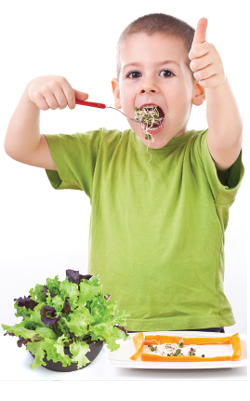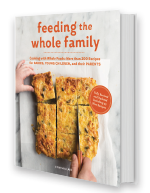Tips for getting your child to love vegetables
by Cynthia Lair
This article was originally published in January 2017

In almost every class that I’ve taught for parents, someone raises their hand to say, “My husband/daughter/son hates vegetables. What should I do?” This is a common worry, especially now that MyPlate (ChooseMyPlate.gov), the current nutrition guide published by the U.S. Department of Agriculture, suggests that half of our plates be dedicated to fruits and vegetables.
- First, assess your own thoughts about vegetables. Make sure you love them, like them, or at least appreciate them before asking your children to eat more of them. What you are thinking transfers to your child, even if it’s unspoken.
- Next, help your child create a relationship with vegetables. One excellent way to improve your child’s interest in vegetables is to let them help you plant and harvest a small vegetable garden. If you don’t have space for a garden, you can grow herbs and small vegetables in pots, in the windowsill or on the patio, or visit one of the many local organic farms in the area. Let your kids see, touch and even smell vegetables being grown.
- Bring your child with you to the grocery store and let them pick out fruits and vegetables that look good to them.
- Invite your child to help you prepare vegetables. Let your child make beautiful arrangements on the plate using the bright colors of the vegetables.
With children who eat their fair share of whole grains, fruits and beans, relax some; these foods contain a wide variety of vitamins and minerals present in vegetables. Remember that children naturally gravitate toward the sweet taste. Roasting carrots or braising brussels sprouts in apple juice sweetens them.
Make sure ample whole fruit is available each day. Remembering that beauty is in the eye of the beholder, here are some ways to prepare and serve vegetables that may appeal to your child.
Juices
Students who take my classes report great success in getting children to drink various vegetable juices. Carrot juice is a favorite, especially mixed with a little apple juice. But remember, juice is not a whole food; the fiber is gone and the sugars become highly concentrated. Dilute vegetable and fruit juices: one half juice, one half water.
Smoothies
Carrots, kale, spinach and all sorts of vegetable goodness can be tossed into a blender with some yogurt, milk or banana to create a drinkable meal.
Dippers
You can use raw vegetables as dippers for your child’s favorite dip. Bean dips, guacamole and tofu dips can be scooped up on a carrot stick, celery stick, or slice of zucchini. To make vegetables easier to chew and digest, as well as enhance their flavor, blanch them.
Soups
Children who refuse a serving of vegetables often will eat the same vegetable in a soup. If vegetables in their whole form are a turnoff, puree the soup (see the recipe for Golden Mushroom-Basil Cashew Cream Soup).
Muffins
You can add vegetables to muffins and other baked goods. Zucchini, corn, squash, carrots and sweet potatoes taste great in a muffin mix (see the recipe for Sweet Potato Corn Muffins).
Sandwich spreads
When pureeing beans or tofu or avocado into a tasty sandwich spread, add in some fresh vegetables. Parsley, cilantro, fresh basil, red bell pepper or green onions work well to enhance flavor and nutritive value. Add corn, grated zucchini or chopped green bell peppers to burritos, tacos or wraps.
Single-ingredient salads
Sometimes it’s just the sight of combined ingredients that turns kids off to salads. Experiment by offering a single raw vegetable or raw vegetables in separate piles, not mixed together. Try different shapes and sizes. Grated beets or radishes, finely sliced cabbage, zucchini, summer squash, or daikon (white radish) or matchstick carrots or cucumbers can be fun to pick up with small fingers.

Cynthia’s recipes
See a selection of recipes from “Feeding the Whole Family”.
Feeding the Whole Family PCC Cooks class
Cynthia’s book, “Feeding the Whole Family,” is a go-to cookbook for families with children. Join Cynthia as she introduces you to the exciting new 4th edition. Take home pearls of family table wisdom about how to plan and execute successful mealtimes (yes, even with a picky eater at the table!). We’ll share a super-homey meal of Cowboy Bean and Beef Chili, Sweet Potato Corn Muffins, Crisp Cabbage Slaw with Pickled Red Onions, and Winter Fruit Compote with Vanilla Nut Cream.
MEMBERS $50, NON-MEMBERS $55
- Sunday, January 8, 2017 Issaquah PCC, 1 to 3:30 p.m.
- Sunday, January 22, 2017 Redmond PCC, 1 to 3:30 p.m.
- Sunday, January 29, 2017 Greenlake Village PCC, 1 to 3:30 p.m.
- Sunday, February 12, 2017 Bothell PCC, 1 to 3:30 p.m.
- Sunday, February 26, 2017 Columbia City PCC, 1 to 3:30 p.m.
To sign up visit PccCooks.com or call 206-545-7112.
Cynthia Lair is an assistant professor at Bastyr University, cookbook author and host of the web cooking show Cookus Interruptus. This piece was excerpted from the “Raising Healthy Eaters” chapter of “Feeding the Whole Family” by permission of Sasquatch Books.
